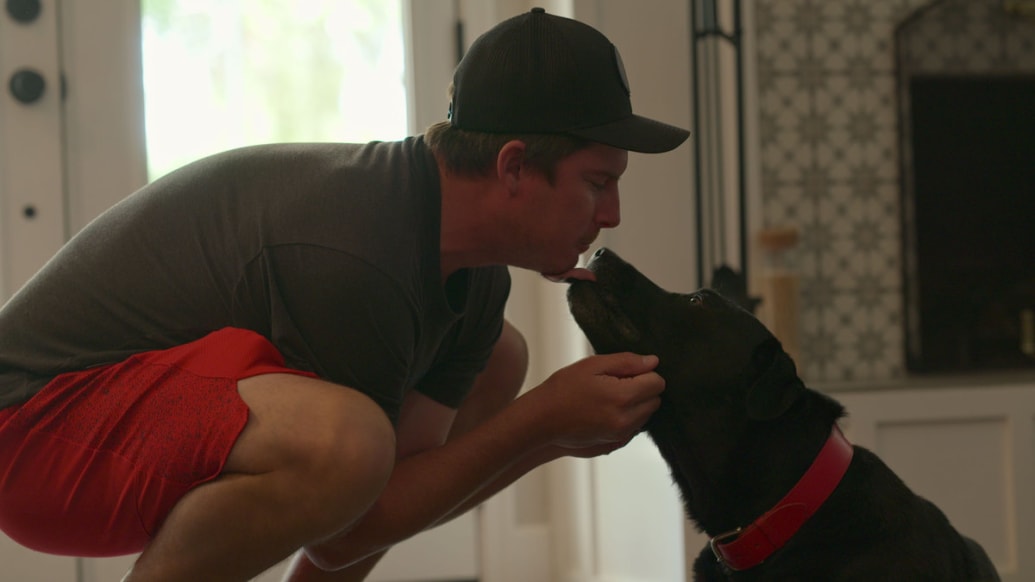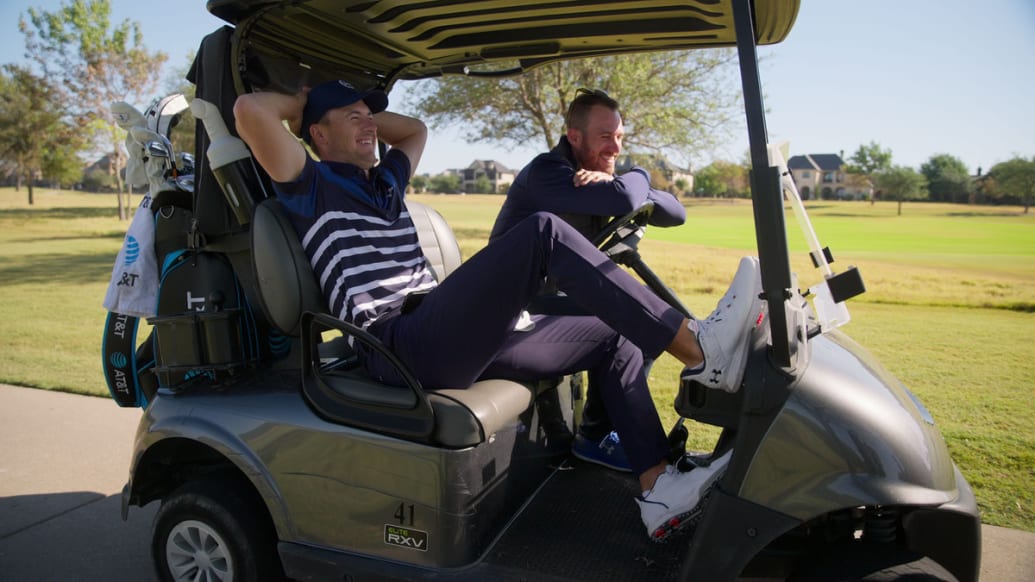My father once gave me two pieces of advice. First, I have financial independence so that I have the ability to leave a bad relationship at any time. And the second? For business and business conversations outside the office: learn to play golf.
(Let’s say I swiped left in golf.)
Let’s just say I’m not a sports fan. And yet, if television is my love language, I’m known for sports-related TV on Duolingo.
In the beginning, sports-related shows like Formula 1 racing seemed too far into my wheelhouse to understand, let alone enjoy. Until I started watching. The moment I open Netflix’s blockbuster series Formula 1: Drive for SurvivalI was totally addicted. Here’s my safe space a flash and glow similar to Bravo TV and real housewiveswith equally engaging storytelling.
And yet, when Netflix premieres Working at full capacityA show focused on the PGA tour, I got bored. This was the vote. This was my dividing line. There was absolutely no way I would find *golf* interesting unless it included Tiger Woods’ ex and a Thanksgiving trip. (Not the kind you shake.)
It turns out that sports-based storytelling works even with – and arguably especially – golf. While every golfer, especially their cadie, has some level of support, ultimately a golfer is playing a power game that can be lost or won with mental determination. All eyes are on them. A person’s soul can be as integral as its oscillation, or even more so.
An existential crisis midway? Save me.
Full Swing divisions focused on individual professional golfers on the PGA Tour. Some professional golfers, such as Tony Finau, Brooks Koepka, and Joel Dahmen, have been featured from the outside, focusing more on personal narrative and how outside challenges affect their play. Others, like Jordan Spieth and Scottie Scheffler, have been shown inside out, focusing more on their games than their personal lives. The show portrayed actors grappling with their legacies, families, disappointments, domestic politics, and uncertain futures off course.
Working at full capacity It’s a solid complement to other Netflix sports shows like jewel in the crown. Drive to Survive and tennis themed Breaking point– especially for those who watch for the story, not because they’re already fans of the sport. And who exactly were the women—like myself—who were unsure whether they would be welcome in an environment outside of their usual interests? Working at full capacity It was on my mind while filming the show.
In an interview with The Daily Beast’s Obsessed, Working at full capacity executive producer Chad Mumm talked about this cross-gender attraction. But first I had to ask. Why golf?
“It’s a really interesting canvas for telling really human stories, because it’s such a lonely sport,” Mumm said. “The individual has to do it on their own. They are kind of islands. The way these athletes process who they trust, what relationships are most important to them, it’s the whole story.”
As for potential audiences like myself who doubt the entertainment value of golf, Mumm noted that what the team focused on was a questionable audience.
“We thought we had a good chance of getting it. [existing] Audiences are out the door,” Mumm said. [were] It’s like, ‘Oh my God, it’s like a lifestyle story here. You know, it can be a little soapy. And sometimes it feels really good. My favorite feedback is, ‘I never expected to cry three times while watching a golf show.’”
Mumm admitted to a perception some of us have about golf: white, bro, masculine, and frankly boring. “A lot of people, maybe you included, have this idea in your head about what golf is. It’s a sport with stigma. And it’s probably a fair stigma. But it’s also changed a lot in the last 10 years.”
He said support engagement has increased across the demographic. He is getting younger now. There are more and more people trying it for the first time. More feminine. It is more diverse. “There is a great preconceived notion. This means you can subvert people’s expectations pretty quickly, which is a great way to connect people. And I think this show took advantage of that.
Transforming Golfers into Real Stars
Asking star athletes who have a lot in the line of reputation for their individual brands and sponsorship values to make reality TV is definitely a big request. “We worked towards gaining trust,” Mumm said, “and some players really embraced it from the start. But we needed to have others there and build the trust and exchange.
Participation in the series has certainly yielded positive results for some star athletes.
For example, look at the role of professional golfer and debuting star Joel Dahmen on the show. Dahmen’s episode focused on his struggle to appreciate and acknowledge his place as one of the world’s top 100 golfers. As Dahmen has often been shown to underestimate and underestimate his skill, other players have discussed his lack of confidence – this was the case during a disappointing start to the US Open qualifiers. But then, after having a few White Claws (wheat for millennials) for lunch, Dahmen came from behind and clinched a point. He led the field at the Open before finally taking 10th place. A straight Cinderella story.
“I said no to that at first,” Dahmen told The Daily Beast. “I was like, ‘I don’t want to be on reality TV and I don’t want my life to be ruined all over the place.’ but i watched some Drive to SurviveI understood what they were after. And then you hear all the other guys doing it and you’re like, ‘Well, the best guys in the world are willing to do it…’”
I asked Dahmen if he felt any additional pressure since the show premiered. “I wouldn’t say [the show added pressure]said. “I put enough pressure on myself. And once you’re in the ropes, it’s just you and the golf ball.”

In fact, Dahmen said the added attention has helped his game. “I tend to get better when I play in front of more people. I’m focusing more because I don’t want to screw things up. It’s easy to get lost there.”
As for how it feels to watch yourself on reality TV? “You know, that’s one of those things, you don’t like little manners and you think you sound funny,” Dahmen said. “But overall, on the deeper side of it, I’m a proud cancer survivor. I’m a brand ambassador for MD Anderson. I wear a bucket hat with the cancer logo crossed out. “So I can be a symbol of hope for the people there and raise money and awareness. So I think it’s all right.”
While Dahmen had a positive experience on the show, others were met with harsh criticism. But it looks like it was going to happen no matter what. Full Swing presence. The golf world was already in a heated debate.
Golf TV’s Uncomfortable Milestone
After Saudi Arabia launched the LIV Tour, ‘disruption’ has become the most important descriptor of professional golf. Now golfers are faced with a decision: play for the LIV and they are permanently expelled from the PGA. This carries a seemingly obvious moral dilemma: whether to participate in a country’s ‘sports wash’ with multiple human rights violations. This is a crisis for the PGA and for players grappling with the future of the sport and their own legacy and reputation.
While other professional sports have worked to reposition player views on morality as irrelevant political discourse – namely, silence – the PGA had another strategy and incentive. The interest in star players like Rory McIlroy speaking out against LIV has had a positive impact on their profits. Working at full capacity He covered the chaos after LIV players quarreled with reporters for asking questions about Saudi Arabia’s human rights abuses. This included golfer Ian Poulter, who joined in the middle of the LIV series, and seemed to be laughing at the questions that didn’t focus on the choice of cashing a (very) big check.
I wished the show was pulled back. both Working at full capacity and the PGA seemed dependent on McIlroy’s LIV-challenging leadership as it sought to alter the PGA round to attract and retain fans. McIlroy’s full-throated criticism of the LIV seemed to have subsided. Working at full capacityA responsibility to challenge LIV golfers like Dustin Johnson, Koepka and Poulter.

Fortunately, there’s always Season 2.
Categorizing and kicking golfers wasn’t as easy as I initially felt, as seen in episodes featuring players Sahith Theegala, Mito Pereiro, and Matt Fitzpatrick. And used to seeing other women openly vulnerable and emotional on reality TV, but not men, this one stood out.
Like the “guilty pleasure” nickname often attributed to female-dominated shows. The sports universe does not have such a consistent critique. And frankly, why would they? Sexism brings an implicit appreciation and value to male-oriented stories and interests. For years, women have been vulnerable, outspoken, reactive, and escapist on reality television. Still, the mostly female audience had to ostensibly apologize for a passion that sports fans, including women, lacked.
And there’s also the difference in how emotions are received. Because of a culture and society built around toxic masculinity, men are seen as brave in sharing their feelings of vulnerability and anxiety. Women’s feelings are typically both criticized and assumed. Female athletes are often penalized for the emotions that men share without any consequences otherwise. Just ask Serena Williams. And Angel Reese.
Watching and writing about sports reality TV has challenged me to ‘reward’ a man’s vulnerability when this positive appreciation for women doing the same is not up to par.
Mumm admitted that she didn’t take into account the gender politics in the game, including how rare it is for men to be seen revealing themselves. “I think it’s an interesting observation, and you know, it’s my fault for not really thinking that way. But it’s true, you don’t really see vulnerability in men, especially in an athlete, masculine men. It’s like crying after a win. Real vulnerability, that often happens.” It’s not something you see.”
Some critics argued that Working at full capacity very flamboyant with its private jets and famous multimillionaire athlete joy of life. At a time when the future of professional golf is changing, they say such displays of wealth can cheapen the brand.
While escaping reality can draw an audience into a show, it’s the small, private, emotional moments that keep people watching and ignite conversation around self-doubt, vulnerability, and stress. And yes, gender politics.
All this was inspired by a show about golf. However, I still don’t know if I should take my father’s advice and take some lessons for myself.